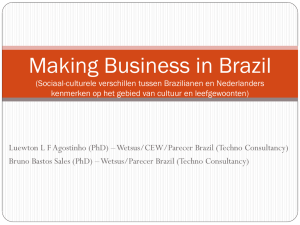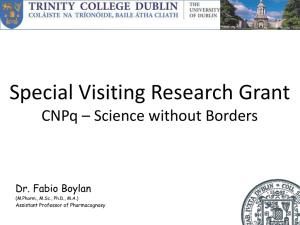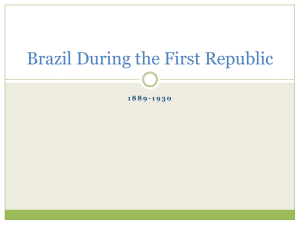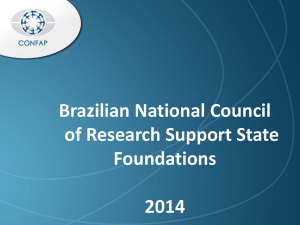Brazil - High Point University
advertisement
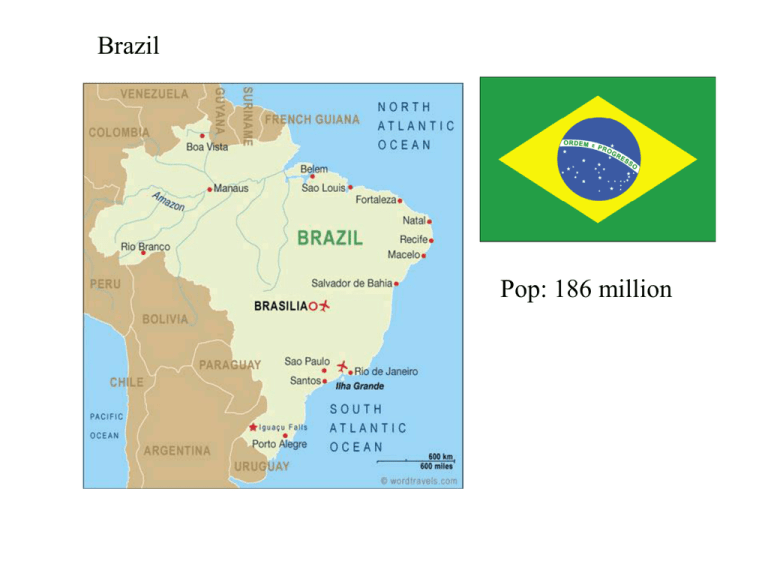
Brazil Pop: 186 million Beyond Football and Carnival Key Points Brazil has a long history of state corporatism. Governments and the public have traditionally opposed market capitalism. In the 20th century, Mexico enjoyed years of stability under the PRI. Brazil has had much greater instability. Many Brazilian leaders have aspired to grandeza but few have delivered. Regionalism The South owes its prosperity mainly due to coffee production and today, most of Brazil’s industries are located in the south, including its large automobile industry. The Amazon is perhaps Brazil’s best known region for both good and bad reasons. The Amazon is Brazil’s critical ecological treasure, but is constantly threatened by deforestation. Amazon River Basin Colonial Brazil 1500-1822 Brazil discovered in 1500 by explorer Pedro Alvarez Cabral. Ruled by the Portuguese as a colony until the Napoleonic wars. Economy based on resource extraction (Gold) Pedro Alvarez Cabral When Napoleon invaded Portugal and Spain in 1808, Portuguese king Dom Joao VI fled to Brazil. When he returned to Portugal, he entrusted rule of Brazil to his son Pedro I. Dom João VI 1767-1826 Brazilian Empire 1822-1889 In 1822, Pedro I declared Brazil independent and himself as emperor of a new constitutional monarchy Pedro maintained considerable veto power over the representative government – the so-called “Moderating Power” in Brazilian politics. Dom Pedro I 1822-1831 Brazilian Empire 1822-1889 His son Pedro II assumed the throne in 1831. Brazil was the only constitutional monarchy in the Americas and did not suffer from the kind of disorder and instability of the former Spanish colonies. By 1889, many viewed Dom Pedro II’s rule as a barrier to modernization and progress. Slavery wasn’t abolished in Brazil until 1888. Dom Pedro II 1831-1889 The Old Republic 1889-1930 Pedro II was forced into exile in 1889 after a military coup backed by powerful coffee planters in the south. A new constitution was established in 1891, creating a directly elected president after the US model. In truth, however, the old republic did not advance democracy very far. Voting rights were restricted to the landed elites, who controlled most state policy under the Old Republic. Like Mexico, Brazilian politics in the Old Republic was best characterized by clientelism and patrimonialism (private interests running state policy). Regional governors and local political bosses (colonels, coronelismo) in the south held a great deal of power. The Old Republic 1889-1930 Café com leite Politics of this period is often referred to as the rule of café com leite reflecting the dominance of coffee and cattle interests. Estado Novo 1930-1945 Getulio Vargas rose to power in a bloodless coup, following a disputed presidential election. Brazil’s economy had suffered heavily following the Great Depression and the collapse of coffee prices internationally. Vargas drew support from the middle class and those disenchanted with the coronelismo and café com leite. Getúlio Vargas 1930-1945 Estado Novo 1930-1945 Vargas’ Estado Novo is was part Rooseveltian New Deal social and economic policies and part fascist models of Germany and Italy. Portugual also had an Estado Novo at the time under the prime minister and de facto dictator Antonio Salazar. Essentially, the Estado Novo is a form of state corporatism – state organized and administered corporations and trade unions. Antonio Salazar of Portugal 1932-1968 Vargas led the state as paternalistic pai do povo (father to the people). Vargas ruled Brazil for 15 years until domestic and international pressure convinced him to hold competitive elections in 1946. The Estado Novo changed Brazilian politics in three important ways. 1. It concentrated power in the presidency and the central government where it had historically been decentralized among the various regional governors and party bosses. 2. It abolished labor unions and reorganized the working class under the state, which undermined the growing support of the communists. 3. The state began to take a strong interventionist role in the economy. From here on, a major political dividing line in Brazil would emerge between those who favored the centralized state intervention system and those who want to devolve more power and freedom to the regions. The Second “Populist” Republic 1945-1964 Despite the emergence of multi-party competition in the second republic, the system was more populist than democratic. Vargas would return to power from 1951-1954, and his successors Juscelino Kubitschek expanded on his tendency toward populist economic nationalism. Juscelino Kubitschek Pres. 1956-1960 Kubitschek’s most famous project was the creation of a new federal city of Brazilia, which symbolizes the extent of state planning in Brazilian society. Brasilia, the planned city, 1956 Architecture of Lucio Costa and Oscar Niemeyer The Second “Populist” Republic 1945-1964 In the 1960s, Brazil’s leadership steadily drifts further to the left, alarming the conservative opposition, especially in the military. Leftist leader and popular Sao Paulo governor, Janio Quandros, captures the presidency unexpectedly in 1960, but resigns in less than a year. Jânio Quadros Pres. 1960-1961 The last president of the second republic Joao Goulart struggled amid an emerging economic crisis. Brazil had financed much of its state intervention policies through international borrowing, and trade and budget deficits led to severe inflation. In 1964, the military stepped in and removed Goulart. João Goulart Pres. 1961-1964 Military Rule (1964-1985) Instead of using the “moderating power” to appoint another civilian successor, the military assumed full state control. Worst repressions occurred during the rule of Artur Costa e Silva (1967-1969) and Emilio Medici (1969-1974). Artur da Costa e Silva 1967-1969 Military Rule (1964-1985) Torture, execution, imprisonment of opposition groups common, press freedoms tightly restricted. Brazil’s National Intelligence Service (SNI) was particularly brutal in cracking down on progressive activists and communists. Many simply disappeared or “went on vacation” as people often said, never to return. Emílio Médici 1969-1974 Still, military rule in Brazil was not as harsh as the dictatorships in Argentina during the “dirty war” or Chile under Pinochet. The regime still allowed elections to take place though they were tightly controlled. Opposition parties were abolished and replaced with two government run parties – the National Renovation Alliance ARENA (the government party) and the Brazilian Democratic Movement MDB (the official ‘opposition’ party). The purpose of the MDB was mainly to serve as an illusion of competition. The MDB was created to lose elections to the military backed ARENA. Transition to Democracy 1984-1988 State-led development continued under military rule with success (the so-called Brazilian miracle) until the oil crisis of 1973 led to spiraling inflation and deepening debt. The oil crisis did, however, increase pressure on the regime to democratize, culminating in the Diretas Ja! (Direct Elections Now!) movement in 1984. Diretas Ja! rally Transition to Democracy 1984-1988 Tancredo Neves of the opposition MDB (Brazilian Democratic Movement) became the first civilian elected president since 1964, but he died of an illness before assuming office. His vice president, Jose Sarney, assumed office in 1985. Tancredo NevesPDMB Pres. 1985 Transition to Democracy 1984- Unlike Neves, Sarney was a member of the military government’s Democratic Social Party, the successor to ARENA. Hence, 1985 was not quite the revolutionary break from military government rule that everyone hoped for. José Sarney-PDS Pres. 1985-1990 Explaining Brazilian authoritarianism Why did democracy fail in Brazil? How could the military manage to rule for two decades? Democratization in Brazil has taken a long slow pace. Opposition to the military regime gradually emerged across a critical mass of Brazilian society to include business groups, university students, the Catholic church, and among the working class seeking the right to organize labor unions independent from state control. All these groups put pressure on the regime that led to the abertura (opening) in 1985. Nevertheless, democratization has been somewhat gradual as the liberalization of politics and the economy has been slow. Business interests have led the charge for economic liberalization, but the working class and state technocrats are opposed to privatization and dismantling of state subsidies and programs. Brazil’s New Republic 1988Brazil’s new constitution, approved in 1988, inaugurated the New Republic. Fernando Collor de Mello, was elected in 1989 on a promise to reform corruptive state politics, but ironically was forced to resign in 1992 on corruption charges resulting from secret electoral slush funds in his party, which subsequently also collapsed. Fernando Collor de Mello- NRP Pres. 1990-1992 Brazil did not find solid political leadership until the election of Fernando Henrique Cardoso of the Brazilian Social Democratic Party in 1995. A former Marxist who embraced market mechanisms in an effort to reform the long-stagnant economy. Fernando Henrique Cardoso Pres 1995-2002 Brazilian Social Democrats In Brazil, Luiz Ignázio “Lula” da Silva, a former shoeshine boy who became a trade union leader and the acknowledged leader of the country’s left, was elected president in 2002. Luiz Inácio Lula da Silva Pres. 2002-2010 Workers’ Party-PT Profile of Luiz Inácio “Lula” da Silva Lula rose to fame as leader of the Sao Bernardo Metalworkers Union, during the 1970s. He was very active in the opposition movement that forced abertura on the military regime, serving some time in prison for his activism. In the 1980s he formed the Workers’ Party as a mass working class party in contrast to the political elitism of most Brazilian parties. In the 1980s and 1990s Lula ran for the presidency and congress on multiple occasions, finally succeeding in 2002 when he moved closer to the center and started campaigning in suits rather than tshirts. In office, he has basically conformed to the policies of his predecessor Fernando Henrique Cardoso, reaching out to the business community, encouraging further economic liberalization, foreign investment, privatization, limiting social spending, and curbing inflation. Policy goals include a number of social programs such as Zero Hunger and commitments to increasing secondary education and reducing the income gap. Between 15-20% of Brazilian adults are illiterate and only 1/3 of Brazilian teenagers attend school compared to 58% in Mexico On foreign policy, he’s taken a middle road, remaining friendly to both Washington and leftists like Hugo Chavez. He’s also been supportive of free trade initiatives like MERCOSUR, despite leftist opposition. He was re-elected in 2006 with strong support from Brazil’s poor majority. “The Anointed” Designated Heir to Lula da Silva First female President of Brazil Dilma Rousseff 2011- The New Republic and its institutions The institutional structure – patterned roughly on the US separation of powers system. Congress is bicameral with a lower house of 513 members called the Chamber of Deputies and a Senate composed of three members from each of Brazil’s 26 states + the federal capital of Brazilia (81 members total). House members serve 4 year terms and senate members serve 8 year terms. Chamber of Deputies Both the lower house and the Senate can initiate legislation and override presidential vetoes. Presidential Palace Brazil also has a Supreme court with the power of judicial review. Supreme Court Like Mexico and the US, Brazil has a federal system of 26 states, where state governors, state legislatures, and municipal governments share power with the federal government. The electoral system and its consequences Brazil has a complicated electoral system for Congress based on proportional representation. Seats are apportioned based on state size and party list vote. However, parties do not have much power in deciding which names get on the lists because citizens may write in their favored candidate along with the party vote. Candidates thus have pressure to get their names out in the election and party loyalties vary considerably. Candidates often rely on political patronage of individual bosses rather than parties. The endorsements of the coroneis are critical. End result is that elections can produce candidates and political parties that are highly disorganized. Representatives have greater responsibility to their constituents (who write their names) than to party platforms. Hence, pork barrel politics and clientelism are common. Weak parties and an underdeveloped party system make the Brazilian congress dysfunctional and shift much of the governing burden onto the presidency. Despite incentives against strong parties, several have emerged with some durability. The largest conservative party is the Liberal Front Party - the descendant of the old ARENA and PDS parties during military rule. Liberal Front Party – old ARENA, PDS At the center is the Party of the Brazilian Democratic Movement (PDMB) and Cardoso’s Brazilian Social Democratic Party (PSDB). Democratic Movement Social Democratic Party Lula de Silva’s Workers’ Party (PT) is the most successful leftist party. Workers’ Party Other more leftist groups like the Brazilian Socialist Party and Communist party have been less successful electorally. Socialist Party The Presidency and the Congress The Brazilian Presidency has more powers than in Mexico. Presidents can veto acts completely or partially (like a line item veto). They can initiate policy on public spending and direct Congressional schedules on legislation. In reality however, the presidency still needs congressional support to make major changes in public policy. Gridlock in parliament can derail a Presidential agenda. The Presidency and the Congress Brazilian presidents try to maintain coalitions of support among multiple parties. To do this, they revert back to clientelism. Presidents control access to a number of federal funds and federal jobs which they trade to congress-members (and friends of congress-members) in exchange for votes. Pork barrel spending is one of the reasons for Brazils consistently large budget deficits. Brazilian economic development To promote economic development in the 1960s, the Brazilian military embarked on a state-led growth strategyImport Substitution Coffee becomes the only substantial export Development also came at important costs to the environment. Brazil’s ecosystem continues to suffer damage from logging, mining, and deforestation for cattle grazing. While Brazilian incomes may have grown significantly on average during the military regime, income distribution became so unequal that Brazil now has one of worst structures of income distribution in the world Cutting deficit spending has proven very difficult, especially in a democratic regime in which many politicians and interest groups can effectively veto unpopular spending cuts. Since the ending of military rule, the private sector has expanded and foreign investment has increased, especially in the automotive industry, where VW, Ford, and GM now have large production facilities in Brazil. The state, however, remains heavily involved in most aspects of the economy though privatizations have become more common. Recent presidents have moved away from the state intervention model toward greater liberalization, including the support of free-trade organizations like MERCOSUR. Issues in Brazilian politics A robust federalism Brazil’s congress over-represents small states. Most of these states are rural states of the northeast and near the amazon. Investment in these areas shifts needed funds away from the majority of the population in the South. There are also accountability problems with the money the federal government hands out to state and local government, with little guarantees or assurances that federal funds go for intended purposes like education, health care or infrastructure. Governors and mayors have a lot of discretion on how to use federal funds, much of which enforces clientelism in the regions. Women and politics Women have become more visible in Brazilian politics since the abertura. Brazil has one of the most vibrant feminist movements in Latin America, despite strong opposition on some issues from the Catholic Church. Nevertheless, women’s representation in Congress and in high level bureaucratic positions remain marginal. With the introduction of laws requiring 20% of each parties candidates to be women, representation of women has increased in Congress to about 8%. Human Rights in Brazil One of the biggest social movements in Brazil is the Landless Workers Movement (MST) which comes into conflict with local coroneis and large landholding interests over land reform. The MST has been the subject of severe repression in some cases. Over 200 members of the organization have been murdered in the past decade. Favelas Can Brazil’s New Republic survive the challenges it faces? Does democracy have a future in South America’s largest country?

